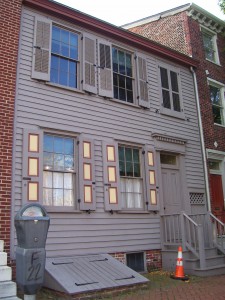

Whitman’s Carriage Stoop
In his later years in Camden, Walt Whitman began receiving many generous gifts and loans. Throughout Camden, Philadelphia, and Southern New Jersey, his network of rich, gift giving, friends had grown very large. For example, his Camden house, at 328 Mickle Street, was purchased for $1,750, of which $1250 dollars came from book royalties, but the other $500 was a loan from his friend George W. Childs. (Reynolds 546) And another generous gift, in May 1887, the journalist and author William Sloane Kennedy started a summerhouse fund for Whitman. The fund came to Whitman in the amounts of $323 dollars and then another $465 sent later. However, Whitman never used the money for a summerhouse; instead he added the money to his personal savings. (Reynolds 554) In 1885, Whitman’s horse and buggy was another, overwhelmingly generous, gift.
The horse and buggy was quite significant. Whitman was 66 when he received the carriage. It was a particularly thoughtful gift. Although, there were means of public transportation available, for example, Justin Kaplan specifically notes the noise and proximity of the trains and ferries that were close to the Mickle Street residence, “night and day trains of the Camden and Amboy Railroad puffed and rattled along about a hundred yards away from the house. It was also earshot of factory whistles, shipping on the Delaware, and the ferry terminal.”(Kaplan 14) As Whitman aged, he began to express troubles with traveling around in the growing city of Camden. The carriage provided a source of an easier, personal transportation.
Prior to the carriage, Whitman was nearly a forced shut in. Being house ridden was especially criminal to a poet like Whitman, who was inspired through his surroundings whether they were rural like his child hood in Long Island or urban like his experiences in Brooklyn, Manhattan, or his then current city, Camden. The adventurous poet could not have been very inspired with out means of exploring his environments.
The rumor of Whitman’s distress started to make its way around his social circles. His network of friends reacted with considerable aid. Thomas Donaldson, a Philadelphia lawyer, had previously obtained free ferry passages for Whitman, a noteworthy gesture, since it was obvious that Whitman enjoyed ferry trips, a better-known Whitman poem is “Crossing the Brooklyn Ferry”. The free passages were also Whitman’s only way into Philadelphia, since the Ben Franklin Bridge was not opened for another 40 years or so in 1926. It was also Thomas Donaldson who eventually secures the horse and buggy for Whitman. It arrives in front of Whitman’s 328 Mickle Street residence on September 17, 1885. Whitman immediately takes a liking to his new carriage. He seemed to have enjoyed the speed so much that he sells his first horse Frank for a faster one named Nettie. He used the carriage often until his second stroke in 1888, when he gave the horse and buggy up for good. (Reynolds 553)
The carriage step must have been installed into the front sidewalk of the Mickle Street residence sometime between 1885 and 1888, which places its age around 121 years old. It is certainly surprising that the stoop stayed so undisturbed for such a considerable amount of time. The picture above shows the clear engraving of Whitman’s initials. The stoop remains in front of the house as a reminder of Whitman’s need for adventure and the generous friends he held around the Camden area.
Works Cited
Dooley, Joseph S. Whitman Carriage Step. Digital image. 21 Nov. 2009. Web.
Kaplan, Justin. Walt Whitman a life.
New York: Perennial, 2003. Print.
Midnightdreary. Walt Whitamn House in Camden. Digital image. Wikimedia Commons.
Wikipedia.org, 13 Oct. 2007. Web. 21 Nov. 2009.
http://en.wikipedia.org/wiki/File:WhitmanHouse-CamdenNJ1.jpg.
Reynolds, David S. Walt Whitman’s America A Cultural Biography.
New York: Vintage, 1996. Print.
